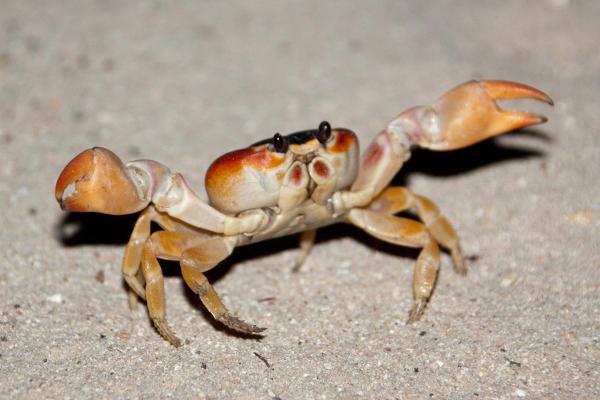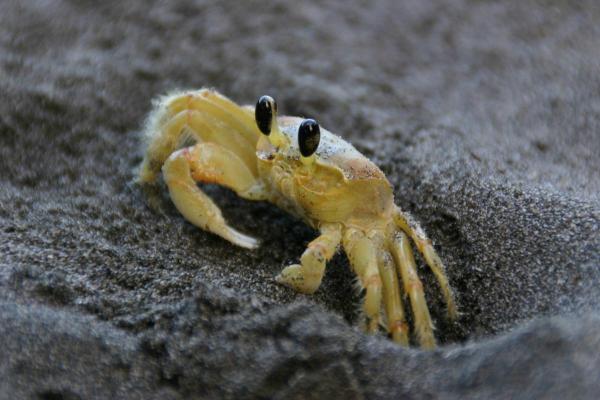Are Crabs Vertebrates or Invertebrates?


A casual glance at a crab on the beach might leave you scratching your head. Their hard shells, sideways shuffle, and grasping claws set them apart from most creatures we encounter. So, what kind of animal are they, truly? Moreover, how can creatures with such seemingly cumbersome forms thrive in environments as varied as coral reefs, muddy riverbeds, and even rainforests?
The upcoming AnimalWised article aims to bring clarity by exploring the classification of crabs within the animal kingdom and addressing the question: Are crabs vertebrates or invertebrates?
Difference between vertebrates and invertebrates
The animal kingdom is categorized into two primary groups based on the presence or absence of a backbone, also known as a vertebral column. This internal structure plays a significant role in distinguishing vertebrates from invertebrates.
Vertebrates:
Possess a backbone composed of bone or cartilage. This backbone provides essential structural support for the body and protects the spinal cord, a bundle of nerves carrying messages throughout the organism. The backbone in vertebrates provides crucial support, protection for the spinal cord, and facilitates efficient movement. As a result, this allows vertebrates to occupy a wider range of ecological niches compared to invertebrates.
In addition to the backbone, vertebrates often have complex organ systems, including a well-developed nervous system with a brain.
Furthermore, they typically exhibit bilateral symmetry (mirror-image halves) and some are endothermic (regulate their body temperature internally). Examples of vertebrates include mammals, birds, reptiles, amphibians, and fish.
Invertebrates:
In contrast to vertebrates, invertebrates lack a backbone. They exhibit a wide variety of body structures. For instance, some have no skeleton at all, while others possess external skeletons made of chitin or calcium carbonate. In fact, invertebrates encompass almost 90% of all organisms, including insects, worms, mollusks, arachnids, and crustaceans.
Their nervous systems vary in complexity, from simple networks to more centralized structures.
Curious about specific examples of vertebrates and invertebrates? Then do not miss this other article.
Are crabs vertebrates?
Crab are classified as invertebrates due to their lack of a vertebral column. Unlike vertebrates such as fish, birds, and mammals, crabs possess an external exoskeleton composed primarily of chitin. This exoskeleton offers structural support and protection, allowing crabs to navigate their environments effectively.
Despite the absence of a backbone, crabs possess well-developed nervous systems, enabling them to perceive their surroundings, make informed decisions, and react efficiently to stimuli.
Why is the crab an invertebrate?
We previously established that crabs lack a vertebral column, a defining feature of vertebrates. This absence is the primary reason they are classified as invertebrates. However, several other anatomical and physiological traits solidify their placement in this category.
Fossil records indicate their origins within the crustacean lineage, dating back to around 500 million years ago during the Paleozoic Era. These early ancestors likely resembled shrimp-like creatures with soft bodies and segmented appendages.
A significant evolutionary milestone for crabs was the development of a sturdy external exoskeleton primarily made of chitin. This innovation replaced the earlier soft body structure, providing enhanced protection and support. This transition from soft to hard exteriors wasn't just for defense; it also greatly improved crabs' mobility and ability to thrive in various environments.
Crabs exhibit significant morphological diversity, which aids their adaptability. This diversity, in turn, contributes to their evolutionary success. Their segmented bodies, typical of many invertebrates, allow flexibility and specialized movement. Jointed appendages, like walking legs and pincers, serve various functions such as locomotion and feeding. Additionally, sensory organs like mobile eyes and antennae enhance perception and communication.
Similar to other arthropods, crabs are omnivores, consuming a varied diet that includes plants, small animals, detritus (decaying organic matter), and aquatic organisms. They primarily breathe through gills, specialized organs that extract oxygen from the water they inhabit. Interestingly, some crab species also possess modified lung structures that allow them to exchange gases with air, highlighting their adaptability to diverse environments.
To delve deeper into the amazing structure and specialized functions of crabs' joint appendages, check out our article.

Classification of crabs
Crabs belong to the phylum Arthropoda, a vast group of invertebrates characterized by their segmented bodies and jointed limbs. Within this phylum, they are further classified under the class Crustacea, which includes lobsters, shrimp, and barnacles.
Despite their distinct appearance, crabs share a common ancestor with other crustaceans. Through the process of convergent evolution, whereby unrelated organisms develop similar traits due to facing similar environmental pressures, both crabs and lobsters have evolved hard exoskeletons and grasping claws. However, their body plans and specific adaptations have diverged over time, leading to their unique morphologies and ecological roles.
The classification system further subdivides crustaceans based on more specific traits. Crabs fall under the class Malacostraca, which includes animals with hardened exoskeletons and specialized mouthparts.
Delving deeper, crabs belong to the order Decapoda, characterized by ten legs (deca = ten, poda = foot). However, within Decapoda, the first pair of legs in crabs is modified into claws (chelipeds), leaving them with eight walking legs.
Finally, most true crabs belong to the suborder Brachyura, distinguished by their short, broad abdomens often tucked under the thorax, giving them their characteristic compact appearance.
Here's the overview general classification of crabs:
- Kingdom: Animalia
- Phylum: Arthropoda
- Subphylum: Crustacea
- Class: Malacostraca
- Order: Decapoda
- Suborder: Brachyura
- Superfamily: Varies by specific family
- Family: Varies by species
It's important to note that there are numerous crab species with different characteristics and adaptations for various habitats, whether marine, freshwater, or terrestrial. Therefore, specific classifications may vary based on the species being considered.
For more information on the classification of invertebrates, dive into our chart with definitions and examples, which offers a clear breakdown of different invertebrate groups
If you want to read similar articles to Are Crabs Vertebrates or Invertebrates?, we recommend you visit our Facts about the animal kingdom category.
- Chang, YJ, Sun, CL, Chen, Y., & Yeh, SZ (2012). Modeling the growth of crustacean species . Reviews in Fish Biology and Fisheries, 22, 157-187.
- Ng, P.K., Yule, C., & Yong, H.S. (2004). Crustacea: decapoda, brachyura. Freshwater Invertebrates of the Malaysian Region . Malaysian Academy of Sciences, 311-336.
- Yeo, DC, Ng, PK, Cumberlidge, N., Magalhaes, C., Daniels, SR, & Campos, MR (2008). Global diversity of crabs (Crustacea: Decapoda: Brachyura) in freshwater . Freshwater animal diversity assessment, 275-286.






